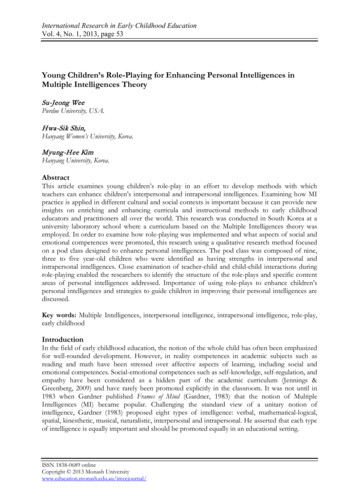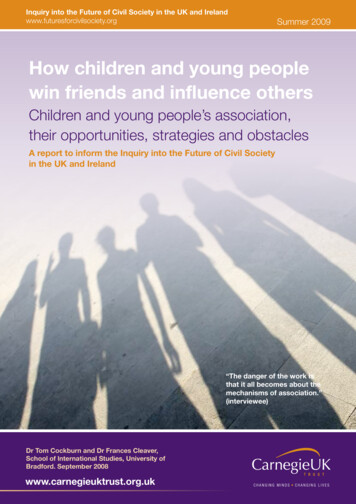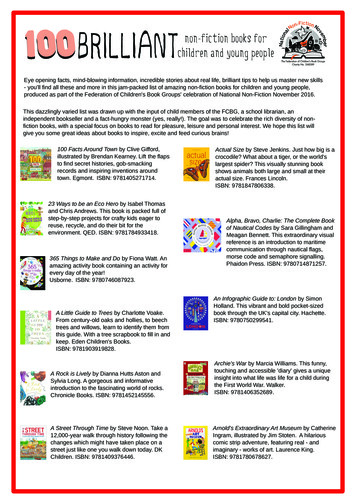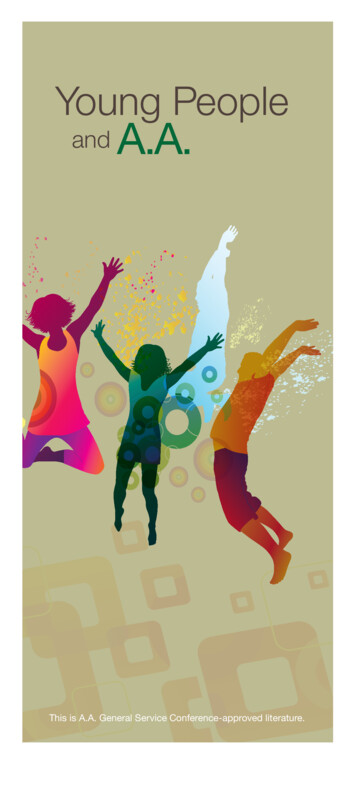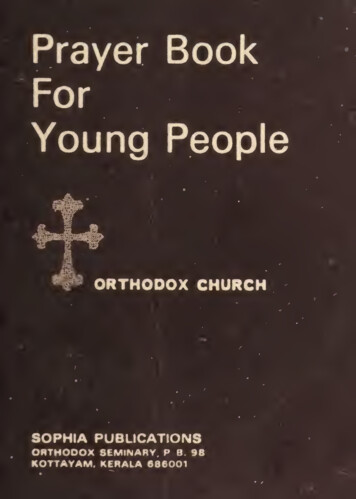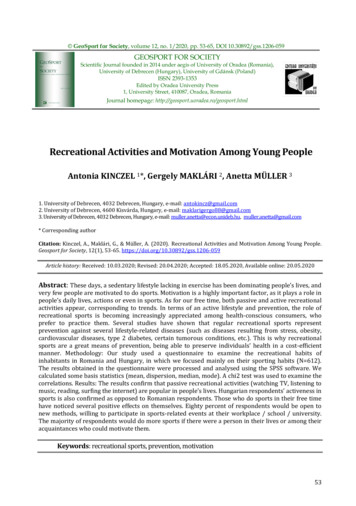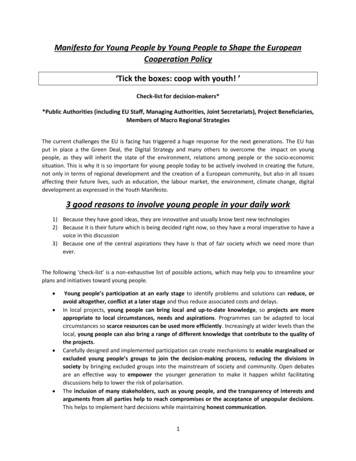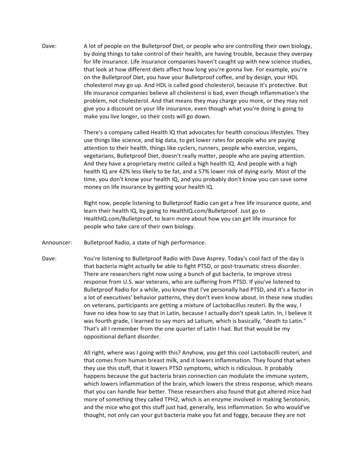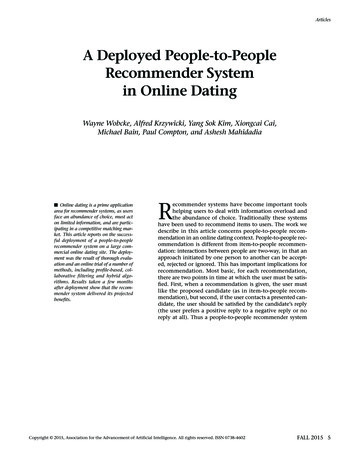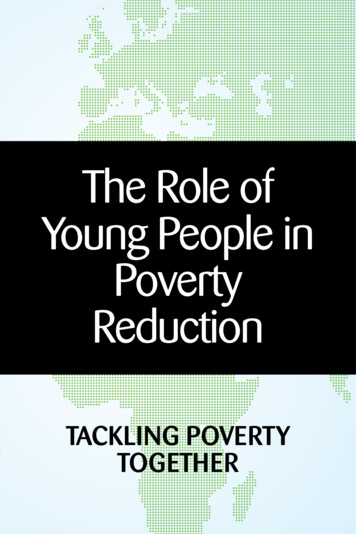
Transcription
The Role ofYoung People inPovertyReductiontackling povertytogether
This document has been financed by the Swedish International DevelopmentCooperation Agency, Sida. Sida does not necessarily share the views expressedin this material. Responsibility for its content rests entirely with the author.“Povertyreduction isnot only aboutmeeting ourbasic needs,it’s also aboutparticipation,influence andpower.”Publisher: LSU – The National Council ofSwedish Youth OrganisationsEditor: Josephine SundqvistDesign: Petra Emtestam, BUKI designPrinted by: Allduplo, Stockholm, 2009Hanna Hallin, President of LSU 2007–2009.
the Role of YoungPeople in PovertyReductionYoung people are seldom recognised as a resource indecision-making processes. Instead, young peopleare systematically excluded from important arenasof decision-making and development processes. As aresult, their perspectives are often absent in policymaking. At the same time, many youth organisationsremain drastically under-resourced and ill-equippedto participate in development processes and efforts.In particular this affects their participation in policymaking and processes relating to Poverty ReductionStrategy Papers (PRSPs).The steps involved in the PRSP process are complex. They include undertaking research and povertydiagnostics, prioritising and costing programmes,as well as keeping track budgets. The issues becomeeven more complex when youth organisations want tohighlight special needs within their group and requiretools, for instance gender-based analysis to addressthe poverty of young women. Even with the right skillsand abilities to discuss, analyse and improve PRSPs,young people do not have sufficient opportunities toinfluence and affect PRSP processes on their own.Youth organisations require support, particularly atnational and local levels, in order to strengthen andput forward their ideas for poverty reduction. Furthermore, the ideas and experiences of young peopleare crucial in order to achieve efficient and sustainable poverty reduction strategies.4This publication explains what a Youth Perspective is and why it is essential in all efforts to fight poverty. It gives a deeper understanding of why it is important that we as young people are integrated andbecome visible as actors in global development. As willbe shown, a Youth Perspective means placing youngpeople at the centre of what we do in order to movemore rapidly and more effectively towards eliminating poverty and achieving the results agreed on in theUN Millennium Development Goals (MDGs).This publication aims at presenting Tackling Poverty Together project as best practice how to implement a youth perspective. Trough Tackling PovertyTogether project 75 youth organisations have workedto create change and increase young people’s role inpoverty reduction at a local, national and global level.LSU– The National Council of SwedishYouth OrganisationsLSU (The National Council of Swedish Youth Organisations)is the organisation that cooperates with and representsthe interests of youth organisations in Sweden. We developyoung leaders and their organisations, as well as aimingto improve the conditions of young people in Sweden andaround the world – in Asia, the Middle East, Eastern Europeand Africa. LSU is a meeting point and centre of competence that with a diversity and rights perspective conducts abroad set of activities within leadership and organisationaldevelopment, as well as promoting its youth policies andadvocacy work. LSU currently has partnerships with similaryouth organisations in large parts of the world, which sharethe same goal of promoting the rights and influence ofyoung people.5
Tackling PovertyTogetherMore than500,000,000youngpeople livein poverty.World Youth Report 2005.The project Tackling Poverty Together was initiatedto convince stakeholders of the importance of working with a Youth Perspective in poverty reduction.LSU have since 2005, together with UNDESA (UnitedNations Department of Economic and Social Affairs)and youth organisations in seven different Africancountries pursued the Joint Millennium DevelopmentProject, called “Tackling Poverty Together – the Roleof Young People in Poverty Reduction”. Tackling Poverty Together is intended to highlight and strengthenyoung people’s role in development policies in general and poverty reduction strategies (Poverty Reduction Strategy Papers, PRSP) in particular.In Tackling Poverty Together LSU and our member organisations, along with UNDESA and severalyouth organisations from each cooperation country,Tanzania, Uganda, Malawi, Kenya, Zambia, Ghanaand Liberia, work to promote the influence of youngpeople on national Poverty Reduction Strategy Papers (PRSP). The project has initiated and created thecapacity for networks of youth organisation networksin seven countries to take actions in order to increaseyoung people’s participation in poverty reductionprocesses. Through the development and implementation of action plans the TPT country teams havegained hands-on experience in research and analysis,strategic planning, and advocacy for greater inclusionin decision-making processes. As a result, young people have achieved greater recognition and involvement in the national processes of poverty reduction.7
Definition of aYouth PerspectiveA Youth Perspective inPoverty ReductionDevelopment objectives cannot be met if young people are not involved and taken into account. A YouthPerspective in poverty reduction is especially relevantgiven that 2/3 of the population in low-income countries are under 25 years old. In addition, most of theseyoung people have significantly limited opportunitiesto exercise their Human Rights such as freedom ofexpression and freedom of association. Upholding aYouth Perspective is therefore an important means ofprotecting young people’s rights.Furthermore, a Youth Perspective in poverty reduction is built on the understanding that young people are not merely a target group but also initiators,participants, decision-makers and leaders. Eliminating poverty requires that young people must be recognised as a resource for change in society. A YouthPerspective is therefore to recognise that youth organisations and young leaders need to be strengthenedand given more space for participation, influence andpower. In realising this it must be considered that alternative forums that give young people influence, forexample youth councils and forums, at local, national,regional, and global levels, must originate from theperspectives and real needs of young people. At thesame time, these forums must not become replacements for true influence in decision-making bodies.81.Young people should be given the chance tobe actors of change and not only be a targetfor development. It affects the quality andrelevance of international poverty reduction.The issues young people face today, such as unemployment, lack of schooling and exposure to violencerepresent enormous social costs to society at all levels. Yet young people have little or no voice in shapingthe current strategies for development. When youngpeople are actors and resources in poverty reductionit leads to better results. If young people are the targetgroup of a project this should imbue all parts of theproject’s phases, from planning to final evaluation.2.Young people have the right to participate,influence and have power over issues that affect our lives. It’s about young people havingthe same rights as the rest of the population.Democracy assumes that individuals are equally important. We emphasise that young people and adultsshould have a mutual influence in our society, irrespective of, for instance, ethnic background and geographical origin. Democracy loses its strength and legitimacy in a society that consistently excludes groupsof people. The goal is to effectively build strategies foryoung people; it is essential to bring our perspectivesand participation into the process at all levels – globally, nationally and locally.
SUMMARYArguments fora YouthPerspective inPoverty Reduction P overty reduction requires knowledgeof youth-specific terms and conditions Y oung people are experts regarding ourown daily life and in ways of reachingyoung people Y outh organisations contribute to thestrengthening of democracy and therespect for human rights W ithout a Youth Perspectivedevelopment policies fail to identifyyouth organisations as actors of change T he Millennium Development Goalsspecifically address young people I nvesting in young people has morepotential than ever, since young peopletoday are the most educated generationeverYoung People– a Significant Groupto DefineThe definition of “youth” is complex and can be defined in different ways. The UN definition of youth ispeople between 15 and 24. The African Youth Charterdefines youth as people between 15 and 35. The Swedish government has defined young people as 13–25years old. To be a young person is not only a matter ofage. Another definition of youth is therefore “a phasewhen a person moves from a time of dependence toindependence”.It should, however, be remembered that youngpeople living in poverty are not a homogenous group.Young people have different values, experiences, andopportunities. Some of us are in school, others are not;some of us have children of our own, others have not.Many face the difficulties of living with HIV/AIDS orcaring for someone who is infected. Because of the incredible diversity among young people, it is more useful to view our needs as being largely determined bywhere and how we live, and to remember that youngpeople differ from one another just as adults do. It istherefore important to acknowledge and respond tothe heterogeneity of young people and act accordinglyto each group’s need.However, what we as young people all have incommon is that we are an underrepresented group indecision and policy making processes.11
Applying a YouthPerspective inPoverty ReductionThere are more young people in the world than everbefore. This fact makes it even more important tomake sure that development policies are reviewedand that young people are given greater opportunities, stronger capacity and a genuine chance. A YouthPerspective in development policies is a potentiallypowerful tool for policy-makers. It also identifies agespecific vulnerabilities, gaps and opportunities forinvestment, and it facilitates co-targeting of interventions, leading to synergies across sectors and ages.A Youth Perspective in poverty reduction contributes to greater efficiency by increasing the probabilityof making efforts that suit different groups of youngpeople. Young people often have the best knowledge ofhow to effectively reach out to other young people andthe best means of doing so. Supporting young peopleto organise themselves is also a way of strengtheningthe work for democracy and human rights.An essential part of applying a Youth Perspective inpoverty reduction is to integrate young people into theshaping, implementation and evaluation of programsand policies. This helps to ensure that the needs ofyoung people are effectively addressed at all levels. Thisdoes not only require more research on youth poverty,but also a more general understanding of the needs andaspirations of those affected – and who would be betterfor the task than the young people themselves?A Youth Perspective contributes to better resultsby relevance, efficiency, legitimacy and democraticdevelopment.12Added value with aYouth Perspective1. RelevanceA youth perspective gives greater relevance topoverty reduction. When taking young people’s knowledge and experience into consideration any targets set become more relevant.2. EfficiencyYoung people can reach young people, as theyoften have the best knowledge of what methods, arenas and approaches will reach otheryoung people.3. LegitimacyWhen young people have the right to participation, influence and power development effortscan gain greater legitimacy. Goals and actionsgain acceptance among young people when theyare included in the implementation of activities.4. Democratic DevelopmentSupporting young people to to organise themselves is a way of strengthening the work ofdemocracy and human rights. A strong civilsociety with youth inclusion is a preconditionfor democratic development and a goal in itself.
“The number ofpeople worldwideaged 12–24 yearshas reached 1.3billion, the largestin history. It is alsothe healthiest andbest educated – astrong base to buildon in a world thatdemands more thanbasic skills.”Paul Wolfowitz; President World Bank Group 2005–2007(World development report 2007)A Youth Perspectiveon MillenniumDevelopment GoalsThe achievements of the UN Millennium Development Goals (MDGs), can clearly illustrate the importance of specifically involving and targeting youngpeople. The (MDGs) can in many ways be seen asyouth goals, and therefore the UN has recently developed specific outcome indicators targeted for youth.The indicators have been developed to be used bothfor regional and country based youth assessment andoffer a number of indicators relevant for measuringthe situation of young people.Global youth unemployment has risen during thelast decade and now amounts to over 80 million people. This is about half the total unemployment in theworld. Evidence shows that the costs of not investing inyouth are beyond belief for our economies. By contrast,if integrated into the development process, we can bea positive force for change. In order to fight the HIV/AIDS pandemic all young people should have access tobasic health services. Maternal health is one of manyexamples, with one woman in three giving birth beforethe age of twenty, and pregnancy being the main causeof death in developing countries for women aged 15–19. Given that the young people are especially vulnerable there are obviously many other health concerns toconsider. For example, many young people live in ruralareas where there is limited access to health services.Also, a substantial part of young people in urban areaslive in slums where they are subjected to air pollution,unsafe water and poor sanitation during the most vulnerable period of their life.15
Youth Organisations Involved inthe Project – in TPT Country Teams1Country Team Zambia(7 organisations)National Youth Constitutional Assembly,Young Women in Action, Global JusticeForum, Youth Vision, Youth Association ofZambia, Young Men Christian Association,Youth Development Organisation.4Country Team Tanzania(5 organisations)25Country Team Kenya(5 organisations)6Country Team Liberia(5 organisations)7Country Team Uganda(4 organisations)8Country Team Sweden(13 organisations)Country Team Ghana(26 organisations)Youth Empowerment Synergy (YESGhana), Global Youth Action Network, Federation of Youth Associations of Ghana,Ghana MDG Coalition Campaign, JaksallyYouth Group, Abibiman Foundation, YoungPeople We Care, Northern DevelopmentSociety, The Green Club, Avert YouthFoundation, West African Students Union,PPAG Youth Action Movement, Vision CareInternational, ECO CLUB Ghana, YoungPeople We Care, Smart Youth VolunteersFoundation, Ghana Girl Guides Association, Action for Community Development,ICCHRA, Ashaiman Zonal Youth Forum,Educare Ghana, Young Peace Brigades,Adventist Youth Association, NationalUnion of Polytechnic Students, NationalUnion of Private University Students, University Students Association of Ghana.3Country Team Malawi(10 organisations)Center for community Empowerment andDevelopment (CECAD), Youth Net andCounseling (YONECO), Chancellor CollegeCatholic Commission for Justice and Peace(CCJP), Foundation for Community SupportServices (FOCUS), Malawi Girl Guides Association (MAGGA), Young Advocates forthe advancement of ICT related development(YAAICTD), Scout association of Malawi(SAM), Center for Youth and Children Affairs(CEYCA), Mzuzu Youth Movement (MYA), Active initiative for Youth Enhancement (AYISE).Tanzania Youth Coalition (TYC) hostorganization, Youth of the United Nations(UNA), Youth serve, Tanzania YouthVision Association (TYVA), Youth InitiativesTanzania (YITA).Youth Alive! Kenya (YAK), Kenya DisabledNetwork (KEDAN), Kibera Community YouthProgramme (KYCP), National Organizationof Peer Educators (NOPE), NYC for Habitat.Federation of Liberian Youth (FLY), ManoRiver Union Youth Parliament, LiberiaYouth and Adolescent Network, ChildrenAssistant Program, Helping Humanity inNeed of Kindness.Network Association of youth organizations of Uganda (NAYOU), Uganda Girlguides Association (UGGA), LyantondeYouth Association, and Youth Alive.The Swedish Social Democratic YouthLeague (SSU), The Centre Party Youth (CUF),The Swedish Association of InternationalAffairs (SAIA), Save the Children YouthSweden (RBUF), The Swedish Red CrossYouth (RKUF), Young Swedish Muslims(SUM), PeaceQuest, YWCA-YMCA of Sweden (KFUK-KFUM), CISV Sweden, Booster,equmenia, Swedish Federation of YoungScientists (FUF) and the Youth League of theSwedish Norden Association (FNUF).
A Youth Perspectiveon UN MillenniumDevelopment Goals(MDGs)Source: The Development Goal Report 2009MDG 4:Reduce child mortalityEvery year 11 million children in the developing world die before theage of five, and since infants born to teenage mothers are 80% morelikely to die, young mothers need to be specifically targeted to help reduce child mortality. A Youth Perspective can thus strategically identifyyoung mothers’ special needs.MDG 5:Improve maternal healthMillions of young women experience complications when giving birthand some of these births end in either long-term morbidity or maternalmortality. A youth perspective clearly links data at a national level onyoung people’s level of education, achievements, child marriage rates,and early childbirth rates to age-specific maternal mortality rates.MDG 1:Eradicate extreme hunger and povertyAccording to the UN’s World Youth Reports 724 million young peoplelive on less than USD 2 a day. If youth were given more considerationin poverty reduction strategies, their ability to help themselves escapefrom poverty would increase.MDG 2:Achieve universal primary education115 million children are not in school and 100 million children whostart school will be forced to leave before they learn to read and write.It is important for young people to complete their education in orderto escape poverty, and youth organisations can support this goal byproviding non-formal education.MDG 3:Promote gender equality and empower womenStrict gender norms can be especially harmful for girls and youngwomen who may find their freedom of movement, educational,personal and economical development, and security severely limited.Young people can break traditions and social constructions related togender inequality and bring about change.18MDG 6:Combat HIV/AIDS, malaria and other diseasesAn estimated 11.8 million young people live with HIV/AIDS today andmany major actors have integrated them into their HIV/AIDS relatedprograms. Youth-led reproductive health education and peer to peereducation has proven to be effective in tackling the pandemic.MDG 7:Ensure environmental sustainabilityYoung people are more willing to take action to achieve environmentalsustainability. This is due to the fact that it is young people that haveto deal with the consequences of not taking environmental sustainability seriously today, as many of the effects of pollution will onlybecome evident over the long term.MDG 8:Develop a global partnership for developmentBuilding alliances and forging partnerships with governments, civilsociety, youth-serving organisations, and the media in order to leverage resources for investing in young people, are crucial to achievingthe MDGs. This can, for example, be achieved as LSU and its partnerorganisations in Tackling Poverty Together are proactively workingwith this issue through advocacy and raising awareness.19
Even though manypoverty reductionstrategies mention th
the poverty of young women. Even with the right skills . As a result, young peo-ple have achieved greater recognition and involve-ment in the national processes of poverty reduction.
